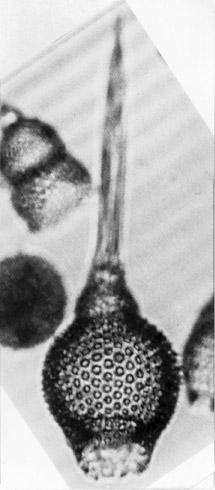 Lamptonium
fabaeforme constrictum Riedel and Sanfilippo
Lamptonium
fabaeforme constrictum Riedel and Sanfilippo Lamptonium
fabaeforme constrictum Riedel and Sanfilippo
Lamptonium
fabaeforme constrictum Riedel and SanfilippoLamptonium(?) fabaeforme(?) constrictum Riedel and Sanfilippo, 1970, p.523, pl.5, fig.7
Generally similar to the nominate subspecies [see description herein], but differing in that at the base of the narrow part of the thorax is a constriction, which is, however, not accompanied by an internal septal ring. The horn is often long, and in some specimens, twisted spirally (Riedel and Sanfilippo, 1970).
Length excluding horn 185-275 µm; of cephalothorax 160-235 µm. Maximum breadth 125-190 µm.
L. f. constrictum is distinguished from other members of the lineage by its robust horn and the constricted upper part of the thorax, and from L. sanfilippoae by not being closed distally (Sanfilippo et al., 1985).
The cephalis is enclosed in the base of the very long (up to 210 µm), robust, bladed, sometimes twisted horn. The base of the narrow part of the thorax is constricted to a varying degree, but does not have an internal segmental division (Sanfilippo et al., 1985).
L. f. constrictum has been found in late early to middle Eocene assemblages from the Indian Ocean at DSDP Site 220, but not further south, at DSDP Sites 313 and 40 in the Pacific, and in the Gulf of Mexico, but not in the open Atlantic Ocean. Its morphotypic first appearance is approximately synchronous with the lower limit of the Phormocyrtis striata striata Zone and its morphotypic last appearance lies within the Thyrsocyrtis triacantha Zone.
L. f. constrictum terminates the lineage that began with L. pennatum.
Additional illustrations can be found in Foreman, 1973, pl.6, figs.13-14.